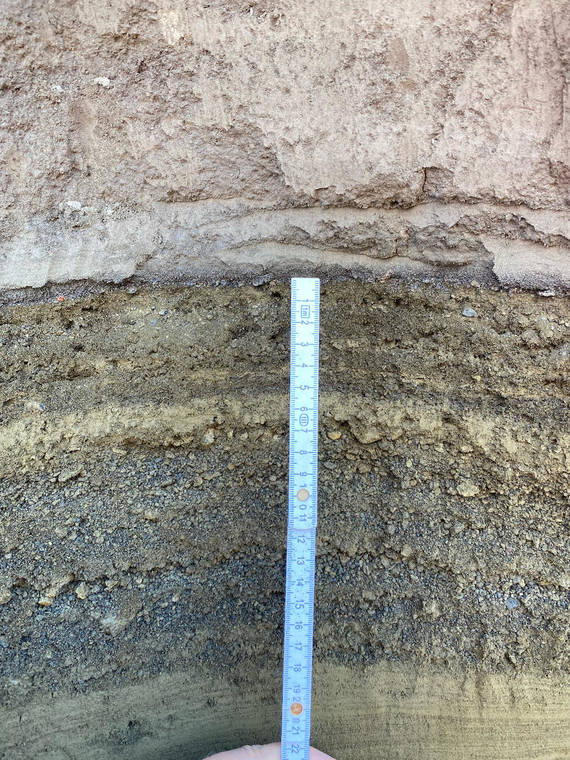Tephra is the Greek word for ash, and it is the label we use for rocks that come flying out of the volcano during an eruption. Every feature of every single tephra grain has something significant to say about the volcanic process that created the grain and the transport journey it took afterward.
Our task as tephra volcanologists is to do the detective work and find as many clues in the grains as possible to help us understand the dynamics of past explosive eruptions. Today, we focus on features that influence transport by air.
There are two ways to begin this journey. One starts from the hot molten magma itself, and the other begins in the wall of the volcanic conduit.
Tephra that starts as fluid hot magma is classified as juvenile. It is a diverse group here at Kilauea that includes smooth-skinned droplets (Pele’s tears), frothy foams, almond-shaped projectiles, denser grains with small isolated bubbles, tiny shards of dark glass, and thin strands of glass (Pele’s hair). Different abundance and size of bubbles cause a wide range of density among various types of juvenile grains. We subdivide them into shards, scoria, pumice and reticulite, in the order of increasing bubble content and decreasing density.
Grains from the wall rock are called lithic clasts. They are created when an explosion destroys part of the conduit wall or picks up talus blocks from a crater floor. At Kilauea, they consist of shattered basalt and are mostly dense and blocky.
After the juvenile or lithic tephra has been expelled from Kilauea, the journey of a single grain is determined by its aerodynamic properties. There are two basic ways to fly.
One is a simple throw from the volcano that will follow a ballistic curve in the air. This is reserved for the big and dense tephra grains that we refer to as juvenile bombs or lithic blocks. The height and length of the journey as a ballistic depends on the force of the explosion that sent it flying as well as its size and density, but it ends with a big thud within 0.6 and 1.2 miles from the vent.
The other mode of flying includes the forces of air and is seen as a plume rising from the vent and spreading laterally across the sky. Tephra travelers in a plume will find that they are lifted much higher than the ballistics and can cover many more miles of distance. However, they literally have to go where the wind blows them.
Once in the plume, these little pieces of rock known as lapilli and ash start their final journey toward the ground. The larger lapilli grains fall faster and end up closer to the volcano, whereas the fine ash grains can stay in the air longer and are the most adventurous. Lithic grains are usually denser and fall faster than juvenile grains, and therefore the lithic ride is shorter compared to a juvenile of the same size. Pumice has a lower density than scoria of similar size and can stay in the air longer. That way both the size and grain type that meets the ground changes with distance as we move downwind from the vent.
Finally, when all the grains have settled there is a layer of tephra on the ground that reflects every single journey of each tephra grain and shows a nice outline of the plume. Wind and water can erode the tephra, but often a tephra layer can stay on the ground for hundreds or thousands of years, faithfully preserving the events of the eruption and waiting for a volcanologist to come along and measure grain size and density of the tephra grains to unfold how they got there.
Volcano Watch is a weekly article and activity update written by U.S. Geological Survey Hawaiian Volcano Observatory scientists and affiliates. Visit https://www.usgs.gov/observatories/hawaiian-volcano-observatory for past Volcano Watch articles, Kilauea and Mauna Loa updates, volcano photos, maps, recent earthquake info, and more. Email questions to askHVO@usgs.gov.
Volcano Activity Updates
Kilauea Volcano is not erupting. Its USGS Volcano Alert level remains at NORMAL (https://www.usgs.gov/natural-hazards/volcano-hazards/about-alert-levels). Kilauea updates are issued monthly.
Kilauea monitoring data for the month of November show variable but typical rates of seismicity and ground deformation, low rates of sulfur dioxide emissions, and only minor geologic changes since the end of eruptive activity in September 2018. The water lake at the bottom of Halema‘uma‘u continues to slowly expand and deepen. For the most current information on the lake, see https://www.usgs.gov/volcanoes/kilauea/k-lauea-summit-water-resources.
Mauna Loa is not erupting and remains at Volcano Alert Level ADVISORY. This alert level does not mean that an eruption is imminent or that progression to eruption from current level of unrest is certain. Mauna Loa updates are issued weekly.



